Jims’ Motorcycle Transmissions
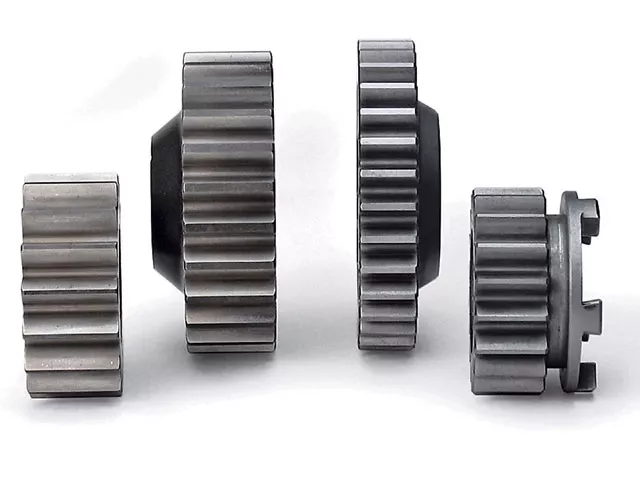
JIMS took advantage of its compact shifter design and redesigned every Fat 5 gear to increase width and strength. Fat 5 gears on the left, stock gears on the right.

Here’s the fully assembled JIMS Fat 5 overdrive transmission with Evo mounts and black Softail case. Included is a Neutral indicator switch and mounting for an electronic speed sensor. Silver and polished cases are also available.
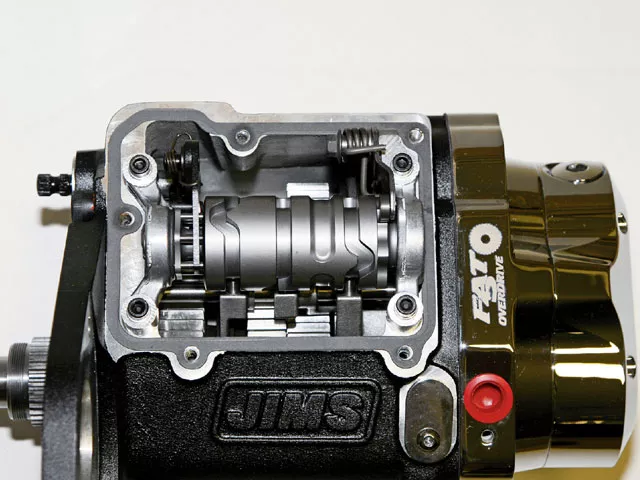
Disassembly starts by removing the top cover’s four Allen-head cap screws and the cover, exposing the shifter mechanism (top left corner), pillow blocks, and shift drum.
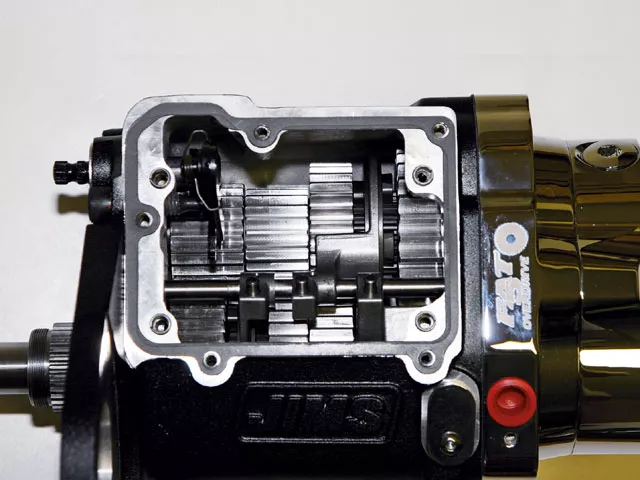
After unbolting four cap screws, the pillow blocks and shift drum were removed as a unit, revealing the Fat 5’s internal gearset, three shift forks, and shift-fork shaft.
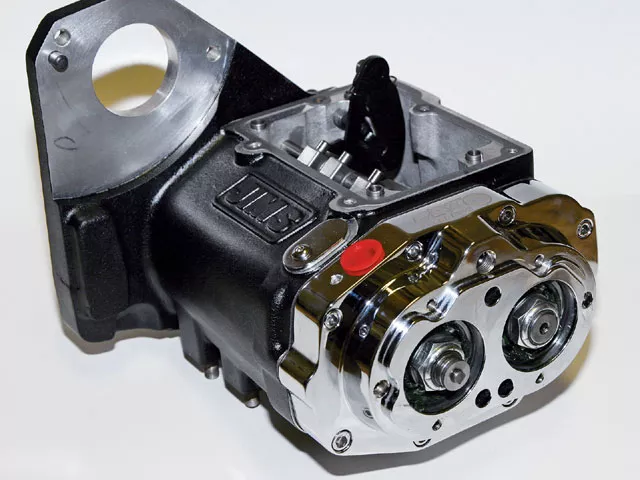
The next step was to remove the chrome side cover, which is attached to the trap door with six cap screws. Now the ends of the mainshaft (left) and countershaft were exposed. The hollow mainshaft contains the clutch-release rod. A chain sprocket or belt pulley can be mounted on other end of the mainshaft for the secondary drive.
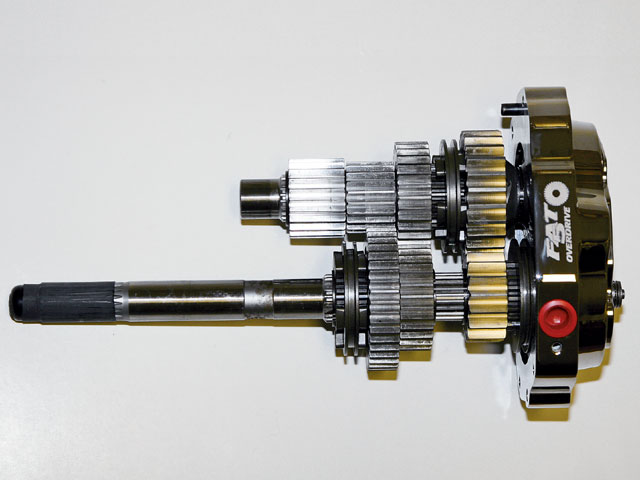
After removing the socket set screw near the top of the trap door, the shift forks and shift-fork shaft were removed. Next, the trap door and gearset were removed from the case after unscrewing eight cap screws. The proper method for removing the trap door is to use the JIMS door puller, although some mechanics tap the left side of the mainshaft with a soft mallet.
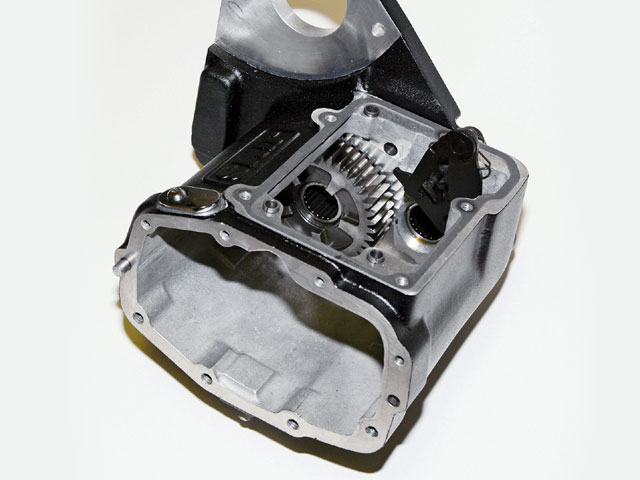
Here’s the Fat 5 transmission case with the mainshaft Fifth gear (top left corner) still pressed into the case. Also seen is the shifter mechanism (top right corner).
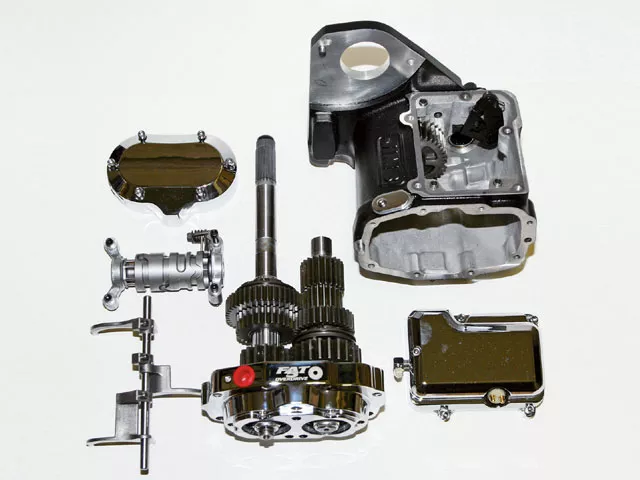
Starting at top right and moving clockwise, they’re as follows: Evo Softail case, chrome top cover, trap door and five-speed overdrive gearset, shift forks and shift-fork shaft, pillow blocks and shift drum, and trap-door side cover.
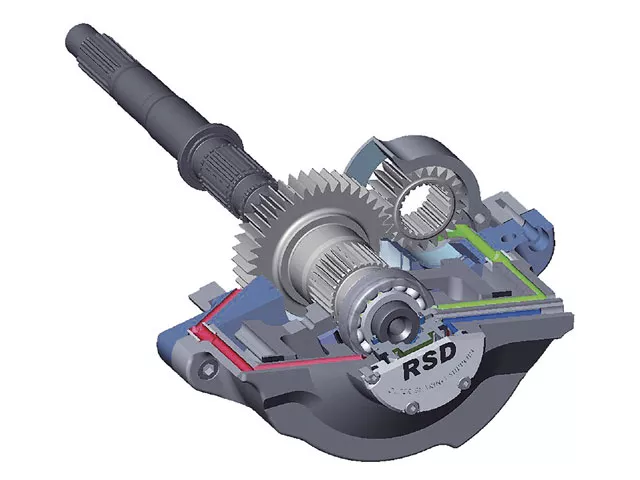
The RSD outboard support bearing for the output mainshaft is lubricated by a pressurized oiling system. The support bearing minimizes flexing of the shaft common in high-torque, wide-tire bikes.
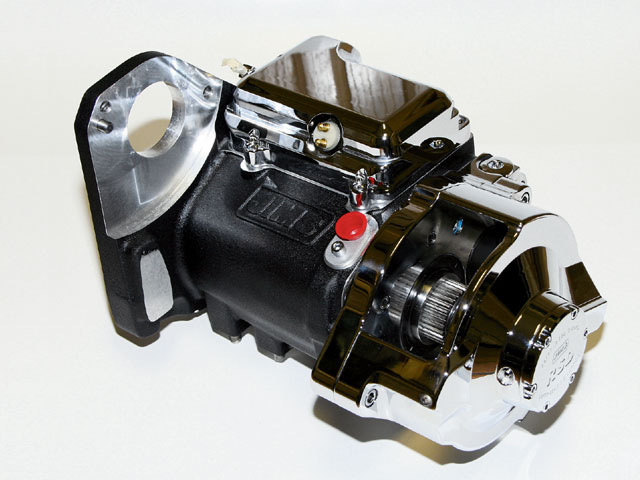
Here is the complete JIMS RSD six-speed transmission with Evo-style black case, hydraulic clutch actuator, and chrome covers. As with the Fat 5, the RSD includes a Neutral indicator switch and mounting for an electronic speed sensor.
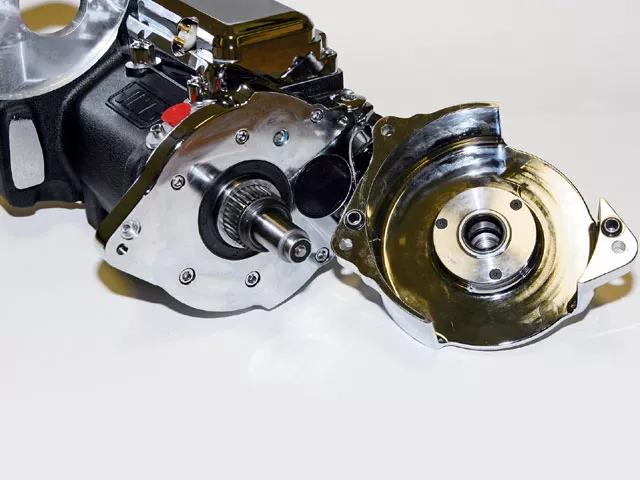
Notice the O-rings over the two hollow dowels. The dowels position the pulley cover to the trap door while providing a feed and return galley for the outboard bearing’s pressurized oiling system. The pulley cover is available with either a hydraulic clutch line or mechanical clutch cable.
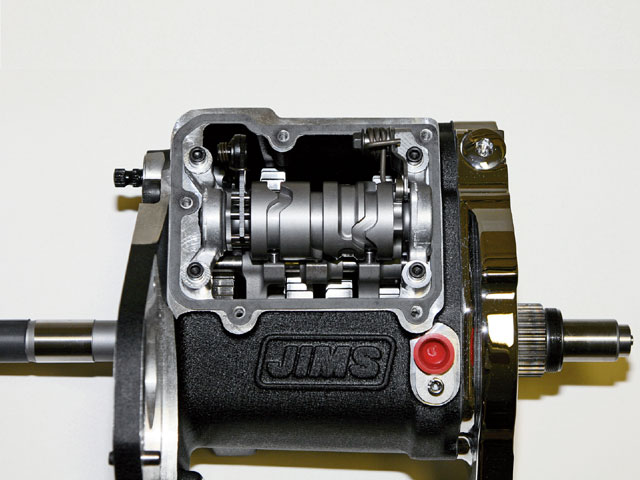
The chrome top cover is unbolted next, exposing the shifter mechanism (top left corner), pillow blocks, and shift drum. Although the shift drum looks similar to the Fat 5’s drum, this one is designed for six-speeds.
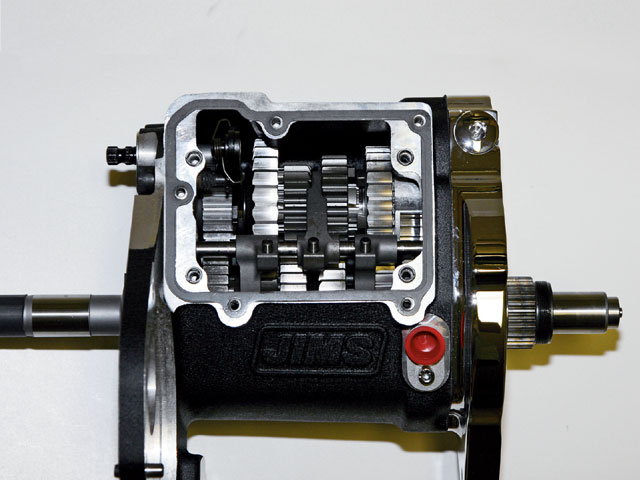
Next, the four cap screws holding down the two pillow blocks were removed, allowing the pillow blocks and shift drum to be removed as one assembly. Shown is the RSD’s six-speed internal gearset, shift forks, and shift-fork shaft.
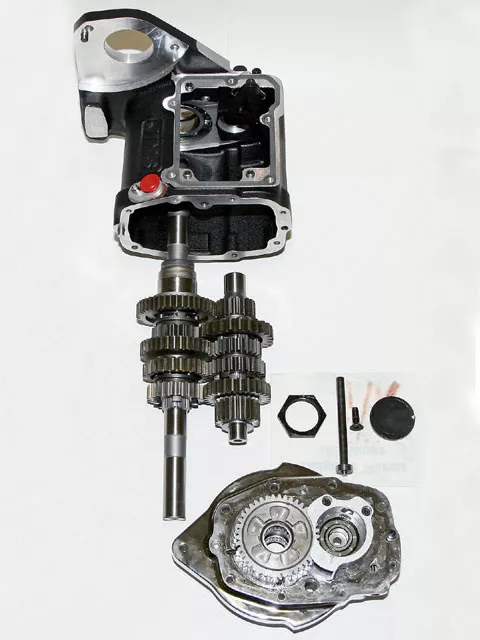
Removing the RSD trap door requires a special JIMS puller that works on other RSD transmissions as well. Unlike a left-side-drive trap door, the mainshaft and countershaft gears are not attached to the RSD trap door. Once the door is removed using the puller, the gears and shafts are removed separately from the case.
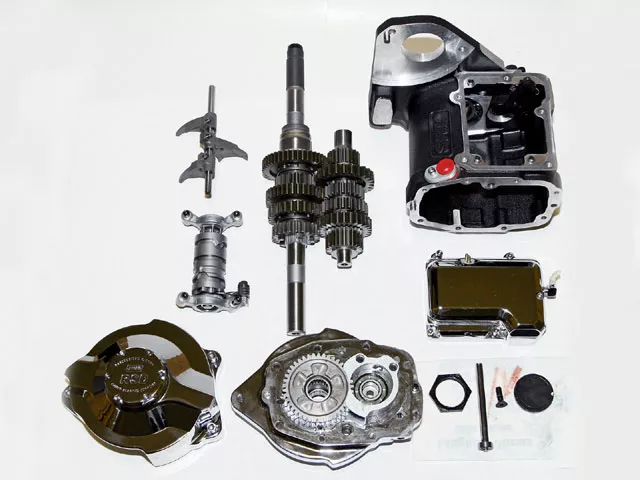
Starting at top center and moving clockwise: six-speed gearset, RSD Evo-style black case, chrome top cover, countershaft bearing seal cover, countershaft lock screw, clutch-release rod, mainshaft locknut, trap door with countershaft bearing and mainshaft Fifth gear, pulley cover, pillow blocks and shift drum, and shift forks and shift-fork shaft.
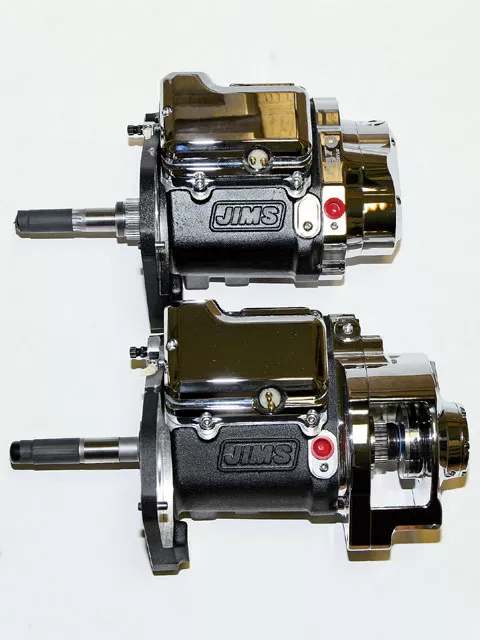
Monster engines and wide tires are a hot ticket, not to mention the dream of many bike nuts. However, stout engines and brawny, road-hugging tires both create unique yet similar drive-train challenges that the bike builder must address to achieve reliability and a balanced ride. Fortunately, the crew at JIMS USA has realized the popularity of this excess. With that in mind, they have developed two transmissions that support high power and wide tires: the Fat 5 overdrive and right-side-drive six-speed. Both transmissions are American made. Gearsets are precision CNC-ground from 9310-AQ material and finished with an AGMA-12 surface. Moreover, the transmissions have been tested with up to 800 lb-ft of torque.
Fat 5 OverdriveTen years ago, 96- to 106-cubic-inch street engines were considered big; today, they are only average at best. Today’s typical big-street engine falls into the 120-something cubic-inch neighborhood, with some engines ranging up to 155 inches and even larger. Monster mills easily double a stock engine’s power and torque, placing enormous stress on a bike’s drivetrain. When ground-pounding power is hooked up to the pavement through high-torque clutches and sticky tires, peak loads rise above what stock transmission gears can handle. JIMS designed the Fat 5 overdrive gearbox to handle such loads.
The Fat 5 overdrive transmission fits both Evo and Twin Cam chassis and is available as a complete transmission or replacement Superkit gearset, which includes gears and shafts assembled to a billet trapdoor. JIMS’ compact shifter technology uses sliding shift rings for gear engagement, which results in quicker and smoother shifting. To support high-power loads from big engines and massive tires, JIMS took advantage of the compact shifter design and re-designed every gear to increase width and strength. The resulting benefits are increases in gear width from 18 to 53 percent, depending on the loads subjected to each gear. Due to the thicker gears, the transmission is 0.870-inch wider on the right side, which may cause interference with the stock exhaust or other components.
The Fat 5 also uses the same “shift ring” technology that is utilized in the ’06 Dyna and all ’07 factory transmissions. Shift-ring technology provides 100-percent tooth-to-tooth contact, resulting in quick, smooth, and positive shifts.
JIMS’ Fat 5 transmission is actually a five-speed gearbox, with Fifth gear being an overdrive. An overdrive transmission offers the benefit of rpm reduction when in top gear without affecting the ratios of the intermediate gears (First through Fourth). The Fat 5’s internal gear ratios are as follows: close-ratio 2.91 First, 1.93 Second, 1.31 Third, 1.00 Fourth, and 0.886 Fifth. Fourth gear results in a direct-drive 1:1 ratio between the engine and rear wheel, while Fifth gear provides a true overdrive ratio, which overdrives the rear wheel compared to the engine. Essentially, the Fat 5 concept takes the ratios of a five-speed gearbox and spreads them equally across four gears, with Fifth gear acting as an overdrive. This is the hot setup for high-torque big-tire applications, because four gears are sufficient for quick acceleration, while the overdrive Fifth gear offers the benefit of rpm reduction for smooth highway cruising.
Right-Side-Drive Six-SpeedBuilding a wide-tire bike is one way to make an attention-grabbing statement. As such, it’s not surprising that fat-tire bikes are so popular these days. But installing a muscular rear tire in a left-side-drive chassis requires a powertrain offset, because the engine and transmission must be moved to the left-or the primary drive spaced leftward (or a combination of the two)-to allow clearance between the drive beltchain and rear tire.
To put this into perspective, consider that a stock Big Twin 130-series tire is about 5.2 inches wide. Installing a 240-series tire (9.6 inches wide) requires about a 2.2-inch offset, and a 300-series tire (12 inches wide) a 3.4-inch offset, depending on the width of the drivebelt or chain. However, such large offsets can create a significant left-side weight bias, resulting in poor balance and ridability. Furthermore, this shift creates less ground clearance on the left side of the bike by reducing lean angle. Generally, the Big Twin can handle about a 200-series tire when using a 1-1/2-inch belt or a 240-series tire with a narrow belt or chain before left-side weight bias becomes an issue with a stock-style tranny. However, if you want optimum balance, a right-side drive is the only way to go, especially if you’re thinking in the 300-series-tire range.
To maintain a balanced motorcycle with a monster-tire application, JIMS introduced its right-side-drive six-speed overdrive transmission, which eliminates the need to offset the drivetrain. The right-side-drive transmission can handle a 280/300-series tire and includes critical design improvements for improved street use and reliability.
For example, standard right-side-drive transmission designs use a longer mainshaft than stock. The longer shaft, combined with high-torque loads from big engines and fat tires, causes mainshaft flex, which can result in premature part failure. To minimize flexing of the mainshaft, which is common in high-horsepower and wide-tire applications, JIMS’ right-side-drive design incorporates an outboard support bearing for mainshaft integrity. A built-in pump pressure-feeds lubrication to the support bearing through an oil galley in the trap door and pulley cover.
The right-side-drive gearbox includes six speeds, with top gear being an overdrive. The internal gear ratios are as follows: close-ratio 2.91 First, 2.19 Second, 1.59 Third, 1.22 Fourth, 1.10 Fifth, and 0.87 Sixth. Gear ratios from First through Fifth are spaced slightly closer together than the Fat 5’s intermediate ratios.
JIMS’ right-side-drive transmissions are available for Evo- and Twin Cam-style transmission mounts and will bolt into most RSD-specific frames with no frame modifications. All case covers are CNC-machined from billet aluminum, then polished and chrome-plated. Black, silver, and polished cases are available. Additionally, the gearbox can be ordered with either hydraulic or cable clutch actuation.
If you’re building a high-torque engine or wide-tire bike, JIMS’ Fat 5 overdrive and right-side-drive six-speed transmissions may just be your ticket to hooking up ground-stumping power and a smooth, balanced ride.
We wanted to see for ourselves what the JIMS Fat 5 overdrive and right-side-drive six-speed transmissions look like, so we decided to disassemble each one. Follow along and see for yourself. We’ll start with the Fat 5.
Here’s a side-by-side profile of the two JIMS transmissions: RSD six-speed (bottom) and Fat 5 Overdrive (top). Both trannys include a Neutral indicator switch, electronic speed-sensor mounting, and stout gearsets. If you have a big-power mill and need a brawny gearbox with overdrive for reduced highway-cruising rpm, consider the JIMS Fat 5 overdrive transmission. For those with a monster engine and wide-tire bike in mind, look at the JIMS RSD six-speed for strength and reliability in addition to smooth, balanced cruising.







